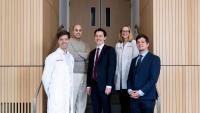Division of Pediatric Radiology

Division Chief
The Division of Pediatric Radiology is devoted to serving the imaging needs of children and their families in a kind, caring, child-sensitive environment. We offer state-of-the-art diagnostic examinations using the newest generation of high-technology equipment and interpreted by dedicated pediatric radiologists. We provide outstanding diagnostic service at the lowest possible radiation exposure for each patient.
Services
The Division of Pediatric Radiology is responsible for the supervision and interpretation of imaging studies of all children in our large outpatient community, as well as inpatients at NewYork-Presbyterian Morgan Stanley Children’s Hospital, a tertiary care hospital that cares for some of the most complex patients in the country. The Division of Pediatric Radiology performs and interprets all types of radiology imaging exams including radiographs, fluoroscopic procedures, ultrasounds, CT exams, and MRI.
Because pediatric patients are more sensitive to radiation, the division champions the use of the lowest dose protocols and equipment including the latest CT scanner technology and EOS scoliosis imaging.

Education
Education is a core mission. The division participates in the radiology residents’ curriculum through multiple conferences per month. The quality of teaching by division members is consistently ranked highly by the radiology residents. In addition, our Pediatric Imaging Fellowship trains up to two fellows per year.

Interdisciplinary Conferences
|
Conference |
Frequency |
|
Pediatric Hepatology Radiology Rounds |
1/week |
|
Pediatric Surgery Radiology Rounds |
1/week |
|
Pediatric Rheumatology Radiology Rounds |
1/week |
|
Pediatric GU-Nephrology Radiology Rounds |
1/month |
|
Pediatric Pulmonary Radiology Rounds |
1/month |
|
Pediatric Tumor Board |
1/week |
|
Pediatric ICU Radiology Rounds |
1/day |
|
Pediatric Vascular Anomaly Rounds |
1/week |
Research
Faculty is involved in varied scholarly pursuits, including NIH-funded research on the use of diffusion tensor imaging to predict bone growth and DOD-funded research on MR lymphangiography in the treatment of thoracic duct injury. Additional interests include innovations in pediatric imaging, including the development of novel bedside fluoroscopy techniques for children and use of artificial intelligence in pediatric imaging.

History
The Division of Pediatric Radiology was established in the 1920's by Dr. John Caffey, scholar and pioneer of pediatric radiology at Babies Hospital. Caffey's first contributions to the medical literature involved the skeletal system and dealt with lead poisoning, rickets, the bony changes of hemophilia, hemolytic anemia, and syphilis. His meticulous, disciplined approach led, in 1945, to the first edition of Pediatric X-ray Diagnosis, a major step toward establishing pediatric radiology as a specialty.
Caffey's description of infantile cortical hyperostoses (Caffey's disease) appeared in 1945, and his observations on the frequent presence of fractures in the long bones of infants suffering from subdural hematomas—that is, battered children—were published in 1946, both in the American Journal of Roentgenology. His recognition of child abuse (battered baby syndrome) made a lasting impact on the care of children. During the 1950s he produced a series of reports defining the normal radiologic appearance of various bones and establishing the normality of several findings that had previously been considered pathologic.
Caffey was succeeded by Dr. David Baker, a trained pediatrician and radiologist, who was subsequently joined by Dr. Walter Berdon. The team of Baker and Berdon was legendary. Publishing hundreds of articles, they were responsible for describing the radiologic findings of both common and esoteric diseases of childhood. Baker and Berdon went on to become presidents of the Society of Pediatric Radiology and the New York Roentgen Society. In 1982, Baker became chair of the Department of Radiology at Columbia University College of Physicians and Surgeons and Berdon became division chief. Berdon won the gold medal of the Society of Pediatric Radiology in 1994 and Baker won the gold medal in 2002. In the footsteps of his predecessor, Berdon edited several editions of Caffey’s textbook of pediatric radiology. He served as the North American editor of Pediatric Radiology for 30 years, and the Berdon Award was established in his honor to recognize the best clinical research paper submitted to the journal in the year preceding the meeting.





